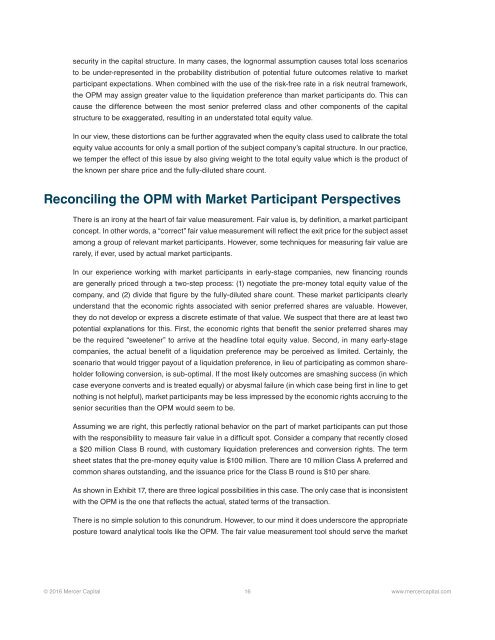A Layperson’s Guide to the Option Pricing Model
Article_Mercer-Capital-Guide-Option-Pricing-Model
Article_Mercer-Capital-Guide-Option-Pricing-Model
Create successful ePaper yourself
Turn your PDF publications into a flip-book with our unique Google optimized e-Paper software.
security in <strong>the</strong> capital structure. In many cases, <strong>the</strong> lognormal assumption causes <strong>to</strong>tal loss scenarios<br />
<strong>to</strong> be under-represented in <strong>the</strong> probability distribution of potential future outcomes relative <strong>to</strong> market<br />
participant expectations. When combined with <strong>the</strong> use of <strong>the</strong> risk-free rate in a risk neutral framework,<br />
<strong>the</strong> OPM may assign greater value <strong>to</strong> <strong>the</strong> liquidation preference than market participants do. This can<br />
cause <strong>the</strong> difference between <strong>the</strong> most senior preferred class and o<strong>the</strong>r components of <strong>the</strong> capital<br />
structure <strong>to</strong> be exaggerated, resulting in an understated <strong>to</strong>tal equity value.<br />
In our view, <strong>the</strong>se dis<strong>to</strong>rtions can be fur<strong>the</strong>r aggravated when <strong>the</strong> equity class used <strong>to</strong> calibrate <strong>the</strong> <strong>to</strong>tal<br />
equity value accounts for only a small portion of <strong>the</strong> subject company’s capital structure. In our practice,<br />
we temper <strong>the</strong> effect of this issue by also giving weight <strong>to</strong> <strong>the</strong> <strong>to</strong>tal equity value which is <strong>the</strong> product of<br />
<strong>the</strong> known per share price and <strong>the</strong> fully-diluted share count.<br />
Reconciling <strong>the</strong> OPM with Market Participant Perspectives<br />
There is an irony at <strong>the</strong> heart of fair value measurement. Fair value is, by definition, a market participant<br />
concept. In o<strong>the</strong>r words, a “correct” fair value measurement will reflect <strong>the</strong> exit price for <strong>the</strong> subject asset<br />
among a group of relevant market participants. However, some techniques for measuring fair value are<br />
rarely, if ever, used by actual market participants.<br />
In our experience working with market participants in early-stage companies, new financing rounds<br />
are generally priced through a two-step process: (1) negotiate <strong>the</strong> pre-money <strong>to</strong>tal equity value of <strong>the</strong><br />
company, and (2) divide that figure by <strong>the</strong> fully-diluted share count. These market participants clearly<br />
understand that <strong>the</strong> economic rights associated with senior preferred shares are valuable. However,<br />
<strong>the</strong>y do not develop or express a discrete estimate of that value. We suspect that <strong>the</strong>re are at least two<br />
potential explanations for this. First, <strong>the</strong> economic rights that benefit <strong>the</strong> senior preferred shares may<br />
be <strong>the</strong> required “sweetener” <strong>to</strong> arrive at <strong>the</strong> headline <strong>to</strong>tal equity value. Second, in many early-stage<br />
companies, <strong>the</strong> actual benefit of a liquidation preference may be perceived as limited. Certainly, <strong>the</strong><br />
scenario that would trigger payout of a liquidation preference, in lieu of participating as common shareholder<br />
following conversion, is sub-optimal. If <strong>the</strong> most likely outcomes are smashing success (in which<br />
case everyone converts and is treated equally) or abysmal failure (in which case being first in line <strong>to</strong> get<br />
nothing is not helpful), market participants may be less impressed by <strong>the</strong> economic rights accruing <strong>to</strong> <strong>the</strong><br />
senior securities than <strong>the</strong> OPM would seem <strong>to</strong> be.<br />
Assuming we are right, this perfectly rational behavior on <strong>the</strong> part of market participants can put those<br />
with <strong>the</strong> responsibility <strong>to</strong> measure fair value in a difficult spot. Consider a company that recently closed<br />
a $20 million Class B round, with cus<strong>to</strong>mary liquidation preferences and conversion rights. The term<br />
sheet states that <strong>the</strong> pre-money equity value is $100 million. There are 10 million Class A preferred and<br />
common shares outstanding, and <strong>the</strong> issuance price for <strong>the</strong> Class B round is $10 per share.<br />
As shown in Exhibit 17, <strong>the</strong>re are three logical possibilities in this case. The only case that is inconsistent<br />
with <strong>the</strong> OPM is <strong>the</strong> one that reflects <strong>the</strong> actual, stated terms of <strong>the</strong> transaction.<br />
There is no simple solution <strong>to</strong> this conundrum. However, <strong>to</strong> our mind it does underscore <strong>the</strong> appropriate<br />
posture <strong>to</strong>ward analytical <strong>to</strong>ols like <strong>the</strong> OPM. The fair value measurement <strong>to</strong>ol should serve <strong>the</strong> market<br />
© 2016 Mercer Capital 16 www.mercercapital.com


